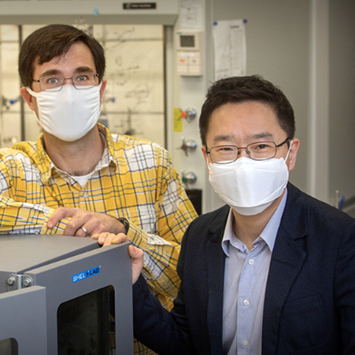

Research Terms
Advanced Energy Technology Energy Storage Sustainable Energy Future Chemical Engineering Chemical Separation Ceramic Materials Materials Characterization Materials Processing Waste Water Treatment Recycling Mineral Resources Membrane Electrochemistry Polymer Physics Energy Conversion
Keywords
Battery Materials Battery Recycling Block Copolymers Charged Polymers Electrochemical Impedance Spectroscopy Electrochemistry Famu-Fsu College Of Engineering Fluorinated Polymers Ftir Spectroscopy Gel permeation chromatography Lithium battery Living anionic polymerization Membrane permeability Neutron spin echo Polymer Blends Polymer Crystallization Polymer degradation Polymer Electrolytes Polymer Membranes Polymer network Polymeric Nanoparticles Rheology of Soft Materials Small-Angle Scattering Small-angle X-ray scattering
The unique physical and chemical properties of most traditional materials are largely determined by the spatial arrangement of the constituent building blocks (i.e. atoms) relative to one another. When the scale of the building blocks extend to the range outside that of atomic elements (e.g. nanoparticles), the 'artificial solids' composed of such nanoparticles exhibit unique properties different from their bulk counterparts. In particular, monolayer two-dimensional (2D) artificial solids, serving as the structural basis for more complicated nanostructures, display distinct collective optical, electrical, and catalytic properties, thus finding vast prospective applications in high-performance solar cells, electrogenerated chemilumines, chemical sensors, transistors, integrated microcircuitry, batteries, capacitors, and thermolectrics. Akin to traditional materials, the physical and chemical properties of artificial solids are not only dependent on the elementary nanoparticle size and shape, but as importantly on the interparticle separation and the periodic arrangement of the constituents.
FSU researchers have successfully prepared monolayer gold nanoparticle (Au NP) films using a water/organic solvent self-assembly strategy. A new approach, “drain to deposit”, is demonstrated most effective to transfer the Au NP films from a liquid/liquid interface to various solid substrates while maintaining their integrity. The interparticle spacing was tuned from 1.4 nm to 3.1 nm using different length alkylamine ligands. The ordering of the films increased with increasing ligand length. The surface plasmon resonance and the in-plane conductivity of the Au NP films both exhibit an exponential dependence on the particle spacing. These findings show great potential in scaling up the fabrication of high-performance optical and electronic devices based on metallic nanoparticle superlattices.
In addition, these FSU researchers have developed a three phase system for depositing monolayer gold nanoparticle films. Using this three-phase system, centimeter-scale monolayer gold nanoparticle (Au NP) films have been prepared that have long-range order and hydrophobic ligands. The system contains an interface between an aqueous phase containing Au NPs and an oil phase containing one of various types of amine ligands, and a water/air interface. As the Au NPs diffuse to the water/oil interface, ligand exchange takes place which temporarily traps them at the water/oil interface. The ligand exchanged particles then spontaneously migrate to the air/water interface, where they self-assemble, forming a monolayer under certain conditions. The spontaneous formation of the NP film at the air/water interface was due to the minimization of the system Helmholtz free energy. However, the extent of surface functionalization was dictated by kinetics. This decouples interfacial ligand exchange from interfacial self-assembly, while maintaining the simplicity of a single system. The interparticle center-to-center distance was dictated by the amine ligand length. The Au NP monolayers exhibit tunable surface plasma resonance and excellent spatial homogeneity, which is useful for surface-enhanced Raman scattering. The “air/water/oil” self-assembly method developed here not only benefits the fundamental understanding of NP ligand conformations, but is also applicable to the manufacture of plasmonic nanoparticle devices with precisely designed optical properties.
The Soret effect arises when a temperature gradient is imposed on a multi-component system, inducing a concentration gradient. There is no comprehensive theory of the Soret effect that applies to all the systems that have been studied. Polymer electrolytes are a novel and interesting system in which to study the Soret effect due to the dissimilar properties of polymers and salts.
Polymer electrolytes provide a system in which the mobility of the components are dramatically different and in which the species solvating the ions (polymer segments) cannot transfer with the ion. This can lead to large partial molal free energy of transfer for ions in polymer electrolyte. In addition, the solid nature of polymer electrolytes precludes convection, which is a vexing source of error in thermal diffusion studies. Studies on polymer blends have found unexpectedly large Soret coefficients near a phase transition. With complex phase diagrams, polymer electrolytes provide an avenue to study this phenomena. In addition, the Soret effect in dry polymer electrolytes could potentially be used to convert waste heat into electricity and improve the efficiency of electrochemical cells.
This technology describes measuring the Soret coefficient in a dry polymer electrolyte by determining the concentration gradient that develops in an imposed temperature gradient. The concentration gradient may be determined using various methods including an electrochemical approach and by magnetic resonance imaging. Transient studies may be used to determine the thermal diffusion coefficient, providing another way to calculate the Soret coefficient. Consideration is given to higher order effects such as non-constant transport parameters by determining the temperature dependence of both thermal mass diffusion and thermal energy diffusion.
The present invention is a blend of a low molecular weight polymer with polyelectrolyte polymer having a precisely fixed anionic motif. This material can be used as to create efficient, highly conductive solid-state batteries with low internal resistance. Solid Polymer Electrolytes (SPEs) are materials that can be used to replace the reactive organic solvents used in lithium-ion batteries. SPEs have drawbacks which prevent its wide adoption, such as low comparative conductivities and propensity to develop shorts. Single Ion Conductors (SICs) can overcome these issues by anchoring the negatively charge ion and allowing only the positively charged ion – typically Lithium ions – the mobility to carry the charge. The present material precisely controls the spacing of the negative ions on the polymer background. This material shows excellent ionic conductivity and has transference near unity.
Key Words : Polymers, Energy Storage, Li-ion battery, solid-state conductor, single-ion conductor






































